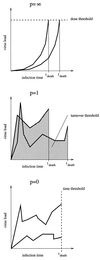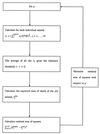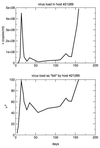Contribution of peaks of virus load to simian immunodeficiency virus pathogenesis
- PMID: 11836438
- PMCID: PMC135930
- DOI: 10.1128/jvi.76.5.2573-2578.2002
Contribution of peaks of virus load to simian immunodeficiency virus pathogenesis
Abstract
The mechanisms causing AIDS and subsequently death in human immunodeficiency virus type 1 infection are not yet fully understood. Nonetheless, correlates of accelerated progression to disease based on immunological and virological markers have been identified. The best correlate identified to date is the baseline virus load or the so-called viral set point. By focusing on a virus load measurement from a restricted time range, however, we ignore valuable information contained in the long-term profile of the virus load. Here, we investigate the relationship between virus load and survival with the aid of a statistical model. The model takes into consideration the virus load at every stage of the disease. In particular, we aim to determine the effect of peaks of virus load on disease progression. We fit our model to unique sequential viral load data of 12 simian immunodeficiency virus mac251-infected rhesus macaques which contain frequent measurements throughout the entire course of the infection until the development of simian AIDS. Our model enables us to predict the survival times of the animals more accurately than an equivalent model which considers the viral set point only. Furthermore, we find that peaks of the virus load contribute less to disease progression than phases of low virus load with the same amount of viral turnover. Our analysis implies that the total viral turnover is not the best correlate of survival. As a consequence, the direct cytopathic effects of virus replication may, by themselves, have less of an impact on disease progression than previously thought.
Figures




Similar articles
-
Virus replication and disease progression inversely correlate with SIV tat evolution in morphine-dependent and SIV/SHIV-infected Indian rhesus macaques.Virology. 2006 Mar 1;346(1):127-38. doi: 10.1016/j.virol.2005.10.026. Epub 2005 Nov 28. Virology. 2006. PMID: 16313937
-
Specific passage of simian immunodeficiency virus from end-stage disease results in accelerated progression to AIDS in rhesus macaques.J Gen Virol. 1999 Dec;80 ( Pt 12):3089-3097. doi: 10.1099/0022-1317-80-12-3089. J Gen Virol. 1999. PMID: 10567639
-
Insights into the Impact of CD8+ Immune Modulation on Human Immunodeficiency Virus Evolutionary Dynamics in Distinct Anatomical Compartments by Using Simian Immunodeficiency Virus-Infected Macaque Models of AIDS Progression.J Virol. 2017 Nov 14;91(23):e01162-17. doi: 10.1128/JVI.01162-17. Print 2017 Dec 1. J Virol. 2017. PMID: 28931681 Free PMC article.
-
HIV-1 fitness and disease progression: insights from the SIV-macaque model.Curr HIV Res. 2006 Jan;4(1):65-77. doi: 10.2174/157016206775197628. Curr HIV Res. 2006. PMID: 16454712 Review.
-
Simian immunodeficiency virus model of HIV-induced central nervous system dysfunction.Adv Virus Res. 2001;56:435-68. doi: 10.1016/s0065-3527(01)56035-2. Adv Virus Res. 2001. PMID: 11450309 Review. No abstract available.
Cited by
-
Major histocompatibility complex heterozygote superiority during coinfection.Infect Immun. 2003 Apr;71(4):2079-86. doi: 10.1128/IAI.71.4.2079-2086.2003. Infect Immun. 2003. PMID: 12654829 Free PMC article.
-
Human cytomegalovirus detection by real-time PCR and pp65-antigen test in hematopoietic stem cell transplant recipients: a challenge in low and middle-income countries.Pathog Glob Health. 2013 Sep;107(6):312-9. doi: 10.1179/2047773213Y.0000000114. Pathog Glob Health. 2013. PMID: 24188241 Free PMC article.
-
The within-host dynamics of infection in trans-generationally primed flour beetles.Mol Ecol. 2017 Jul;26(14):3794-3807. doi: 10.1111/mec.14088. Epub 2017 Apr 4. Mol Ecol. 2017. PMID: 28277618 Free PMC article.
-
Simian-human immunodeficiency infection--is the course set in the acute phase?PLoS One. 2011 Feb 17;6(2):e17180. doi: 10.1371/journal.pone.0017180. PLoS One. 2011. PMID: 21359149 Free PMC article.
-
Modelling cytomegalovirus replication patterns in the human host: factors important for pathogenesis.Proc Biol Sci. 2006 Aug 7;273(1596):1961-7. doi: 10.1098/rspb.2006.3506. Proc Biol Sci. 2006. PMID: 16822758 Free PMC article.
References
-
- Antia, R., B. R. Levin, and R. M. May. 1994. Within-host population dynamics and the evolution and maintenance of microparasite virulence. Am. Nat. 144:457-472.
-
- Cheng-Mayer, C., D. Seto, M. Tateno, and J. A. Levy. 1988. Biologic features of HIV-1 that correlate with virulence in the host. Science 240:80-82. - PubMed
-
- Efron, B. 1979. Bootstrap methods: another look at the jackknife. Ann. Stat. 7:1-26.
-
- Efron, B., and R. J. Tishbirani. 1993. An introduction to the bootstrap. Chapman & Hall, New York, N.Y.
Publication types
MeSH terms
Substances
Grants and funding
LinkOut - more resources
Full Text Sources
Research Materials

